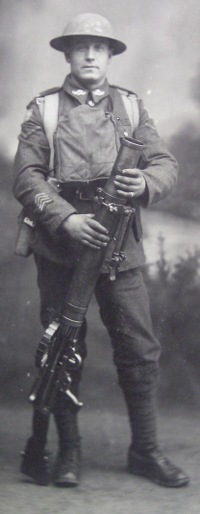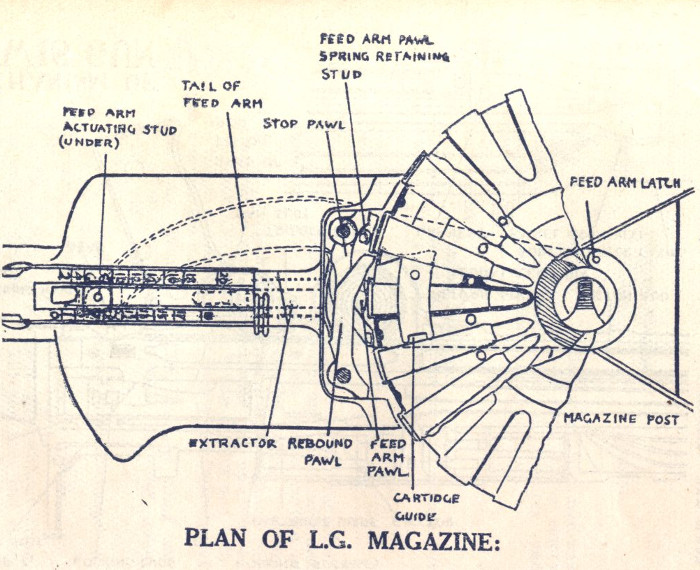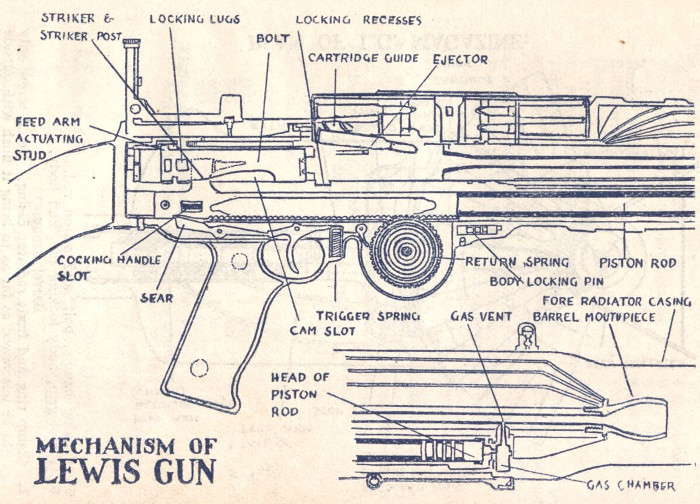Topic: Militaria

Lewis Gun Fires 400 Per Minute
Weapon Which Ontario Government Will Supply to the Forces
The Montreal Gazette, 23 July 1915
 The machine guns which the Ontario Government will supply to the Canadian forces at the front at a cost of $200,000 might rather be termed rifles. The official name of the weapon is "The Lewis Automatic Machine Gun," but it weighs only 25 pounds without its tripod support, which is four and a half pounds in weight. Thus the whole gun may be carried about by one man, and operated by one man, without difficulty. A powerful man may even use the weapon from the shoulder, as though it were an ordinary rifle.
The machine guns which the Ontario Government will supply to the Canadian forces at the front at a cost of $200,000 might rather be termed rifles. The official name of the weapon is "The Lewis Automatic Machine Gun," but it weighs only 25 pounds without its tripod support, which is four and a half pounds in weight. Thus the whole gun may be carried about by one man, and operated by one man, without difficulty. A powerful man may even use the weapon from the shoulder, as though it were an ordinary rifle.
The gun can fire 400 rounds a minute, including the time necessary to change magazines, each of which contains 47 rounds. It is in operation in the French and Belgian trenches at the present time, and is somewhat similar to a Hotchkiss automatic rifle, employed by the French.
The Lewis gun is designed in such a manner that the only tool necessary to dismantle it completely is an ordinary service cartridge, the point of whose bullet is used to disconnect every portion of the mechanism, and this operation is a such a simple matter that the gun can be dismantled, and any small damaged part replaced, well within five minutes. The weapon takes the service ammunition, and its range is similar to that of the service rifles. When used on a fixed mount, the butt stock may be removed and a "spade handle" substituted.
The gun is of very ingenious construction. A detachable magazine loaded with 47 cartridges is attached to a suitable fixing on the barrel near its after end, the first cartridge being fed from the magazine into the firing chamber by the first forward movement of the firing pin, which is, however, arrested before the striker reaches the cartridge unless the trigger is held back. When the trigger is pressed, the striker, carried forward by the mainspring, explodes the cartridge in position in the firing chamber. Before the bullet leaves the barrel, under the influence of the gas pressure, it uncovers a hole connecting the barrel with a cylinder below, lying parallel with it, and a portion of the gas passes into the lower cylinder driving back this piston, and, with it, the rod against the pressure of the mainspring. The movement of the rod recocks the gun, throws out the expended cartridge case, and during the early stage of its return journey, under the mainspring's influence, transfers a live cartridge from the magazine to the chamber.
If the gunner lets go of the trigger firing ceases, and the gun remains cocked until the trigger is again pressed. If, however, he keeps a continuous pressure on the trigger, the weapon continues to fire until all the cartridges in the magazine are exhausted, the rate of continuous fire being as high as 440 rounds per minute, including the interval occupied by replacing empty magazines with loaded ones.
The dissipation of the intense heat developed by the almost continuous combustion of explosive charges in the barrel of the machine gun presents a somewhat difficult problem, and failure to accomplish this efficiently causes the barrel to become red hot and prematurely to explode the incoming cartridge. The barrels of the Lewis gun and the Hotchkiss gun are both cooled by means of ribs which radiate the heat into the atmosphere, those of the Lewis gun being placed longitudinally and contained in a steel casing, through which cook air is drawn by the "exhausting" effect of the powder blast in the muzzle end of the casing, in the same way that air is drawn through the fire-box of a locomotive by the blast of the exhaust steam in the chimney.
The recoil on the Lewis gun is counter-balanced in a very simple and ingenious manner, the gas from the discharge being directed by means of a cone attached to the muzzle of the barrel proper, on to the inner surface of the casing, so that the friction between the gas and the metal casing tends to carry the gun forward with the stream of gas, and so counter-balance the force of the recoil acting in the opposite direction. The mainspring of the Hotchkiss gun takes the form of an ordinary coil-spring acting in compression situated in the cylinder underneath the barrel; whilst the same unit in the Lewis is a spring of the type used for the mainspring of a watch, but naturally of a much greater power. This spring is coiled up in a circular case attached to the gun just in front of the trigger, in a position sufficiently far from the barrel to be unaffected by the heat, and, consequently, in no danger of losing its temper from overheating. The Hotchkiss mainspring acts directly on the piston rod, which it surrounds; whilst the Lewis is coupled to its rod by a rack and pinion.
The magazine of the Lewis gun is circular in shape, the forty-seven cartridges with which it is loaded being radially in two layers with their bullets pointing toward the centre.



